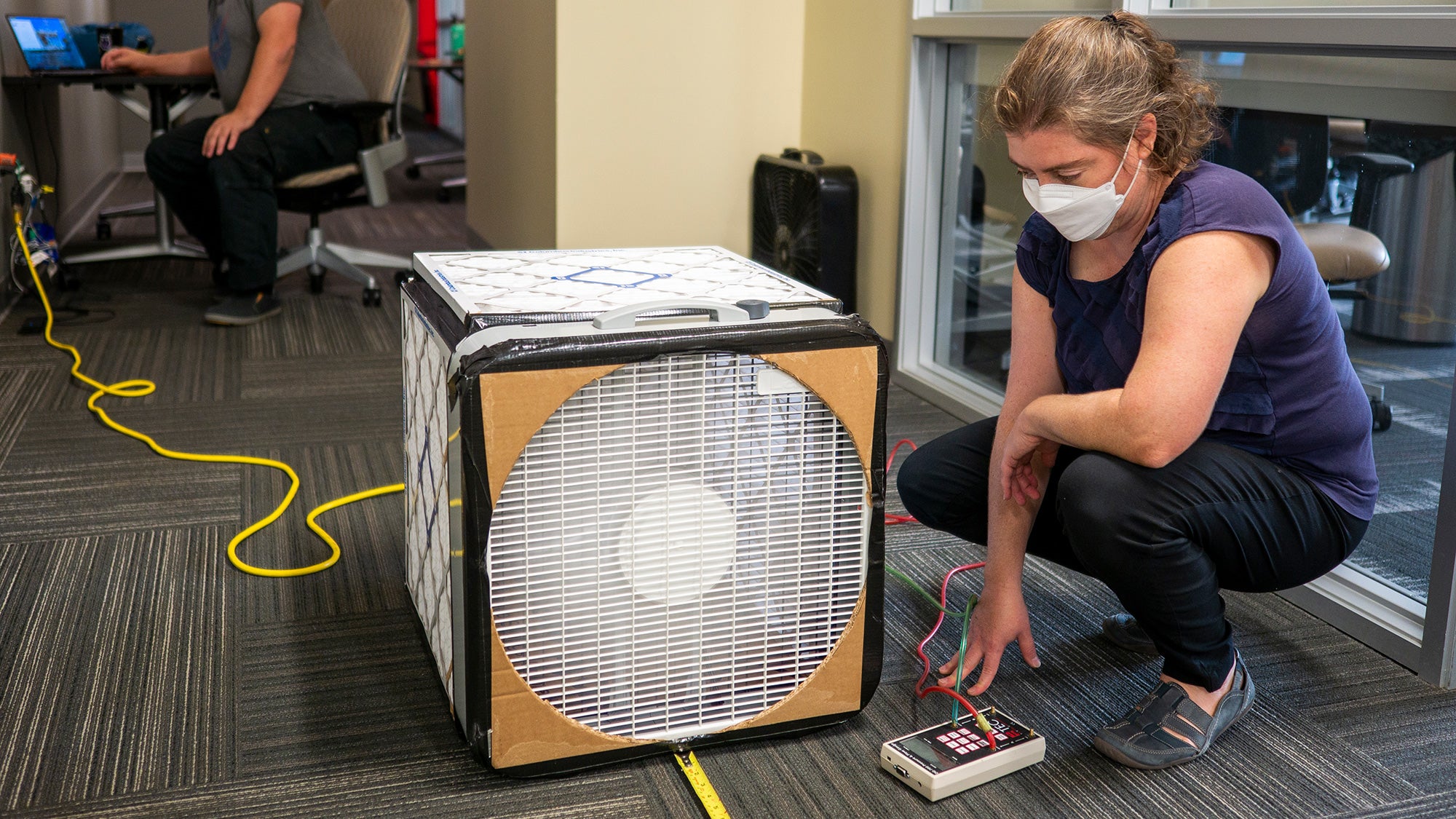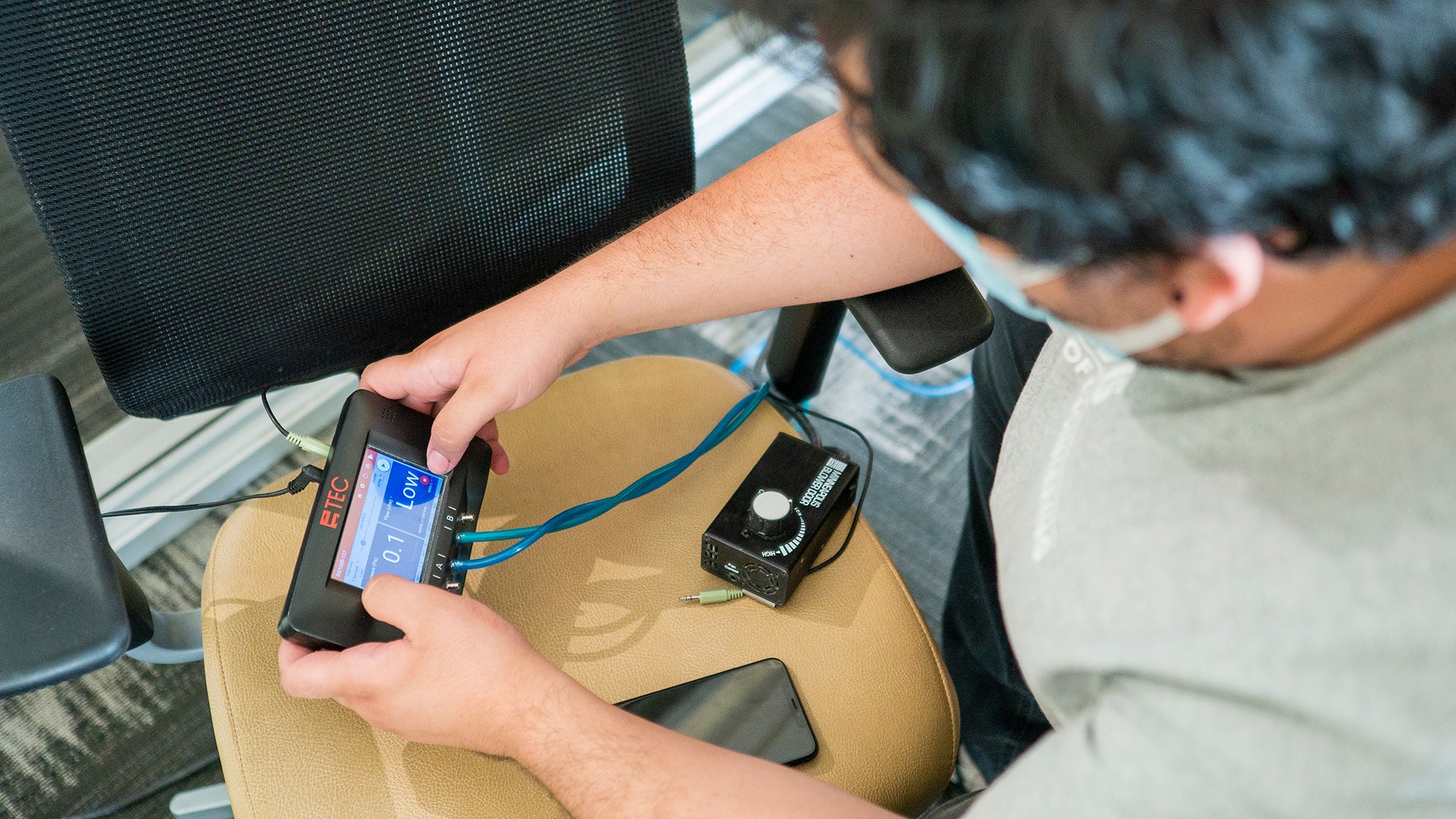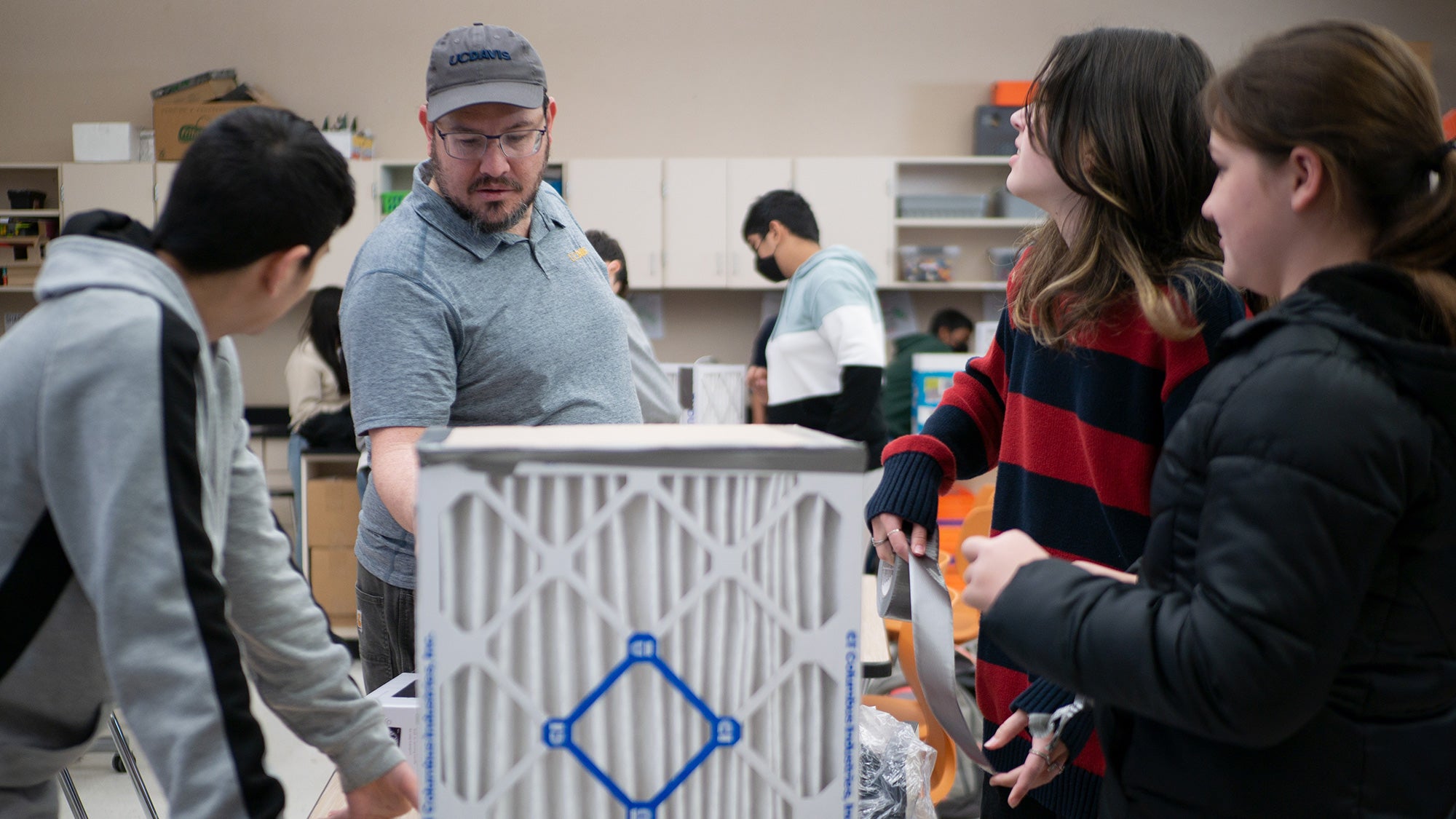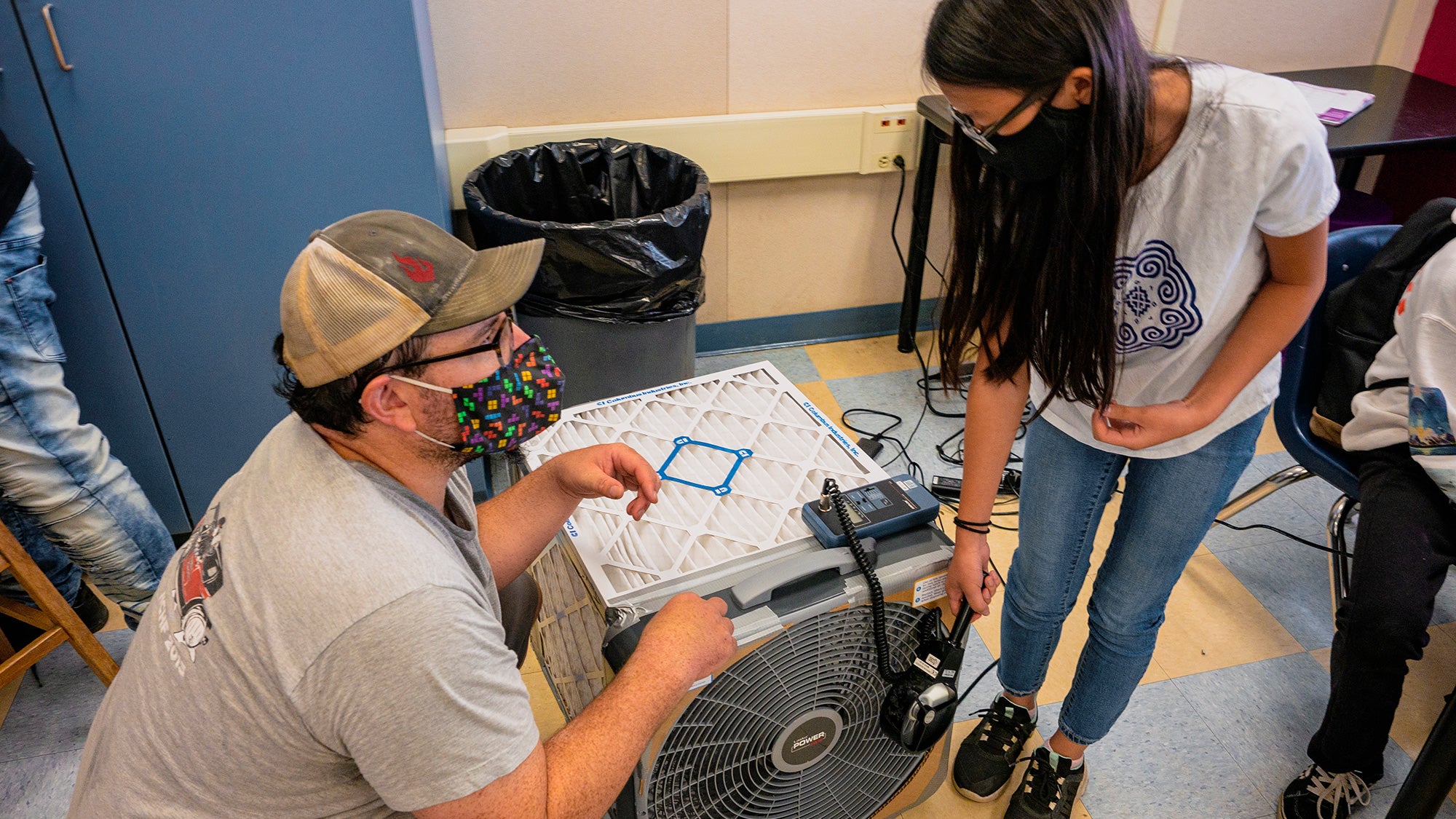In the time it takes to type this sentence, I will have taken three breaths. Twelve in a minute, 20,000 a day, 7.5 million a year, most of them indoors. Yet until quite recently, researchers have not paid much attention to the quality of indoor air.
“It used to a be a pretty robust field, dominated by airborne infectious disease transmission, up until the 1960s,” said Richard Corsi, dean of the UC Davis College of Engineering. Ironically, the growing environmental movement, passage of the Clean Air and Clean Water Acts and the formation of the Environmental Protection Agency, all in the 1970s, moved the focus to outdoor pollution.
“The Clean Air Act was focused entirely on outdoor air and trying to reduce the amount of smog and other air pollutants in cities,” Corsi said.
The COVID-19 pandemic marked a significant change, prompting scientists and engineers to unravel the complex factors that go into indoor air quality. UC Davis researchers are studying ways to optimize the flow of outdoor air into buildings for both energy efficiency and reducing exposure to pollutants, and are taking a close look at how viruses and other pathogens travel from person to person via indoor air currents. Their work could mean better health at home and increased productivity at work.
Indoor exposure to air pollution
Corsi brought his work indoors in the 1990s.
“I was doing outdoor air work and I realized how little work had been done on indoor air, realizing that most of our exposure to pollution of outdoor origin happens when we're inside,” he said. “And you add this interesting chemistry and microbiology that's happening indoors, it's like a wide open frontier. It just excited the heck out of me.”
Corsi chaired a National Academies of Sciences, Engineering, and Medicine committee, which issued a report last year urging action to reduce indoor exposure to ultrafine particles, known as PM2.5, especially in schools.
Epidemiological studies of outdoor air pollution have shown a clear link to human health. But most of that exposure to outdoor pollution actually occurs indoors, because outdoor air pollutants infiltrate indoors where most Americans spend most of their time.
“We're exposed to things where we are, and we spend more time indoors than we do outdoors,” said Deborah Bennett, professor in public health sciences and at the UC Davis Environmental Health Sciences Center.

Air quality and energy efficiency
At the Western Cooling Efficiency Center at UC Davis’ West Village, Engineering Manager Theresa Pistochini is experimenting with how HVAC control systems make decisions.
“The question is, at any given moment in time, what would be the best decision for the outside air rate, [or how much outdoor air is flowed inside], and that's dependent upon what's happening in the building and what's happening outside,” she said.
If you have a pollution source indoors, such as chemical fumes, you might bring in more outside air to dilute and push the polluted air out. But if the air outside is polluted, for example with wildfire smoke, you may want to filter it or keep it out entirely. Some pollutants, such as particulates from smoke and vehicle exhaust, allergens and dust can be filtered out, but others cannot.
“And then you also have to think about the energy implications of more outside air. For example, on a cool summer morning, outside air can be used to cool the building economically in advance of a hot day,” Pistochini said.
Non-residential buildings pose different problems to homes. Their HVAC needs are usually dominated by cooling, because larger buildings have a relatively lower surface area and people inside them generate heat. They typically bring in outside air through dampers that can be opened or closed. To save energy, air systems in California buildings have economizer modules that automatically open dampers to bring in more outside air for cooling.
“If that outside air is polluted because of wildfire smoke, then we're exposing everyone in the building to excessive amounts of outdoor air pollution in the name of saving energy,” Pistochini said.
The forced-air HVAC systems found in family homes, on the other hand, recirculate air within the house. Outside air mostly gets in when you open doors or windows; it also can make its way through gaps, cracks and poorly sealed walls.
“In particular in larger buildings, HVAC systems have been designed over many decades to minimize energy use, with much less consideration for indoor air quality issues,” said Chris Cappa, professor and chair of the Department of Civil and Environmental Engineering.
“A lot of Theresa's work has been thinking about how we go from just mostly thinking about energy and cooling or heating to also think about how we can run our systems to improve indoor air quality,” he said.
Pistochini, with Bennett, has worked extensively with California schools on improving air quality in classrooms. A study by the Lawrence Berkeley National Laboratory of 162 classrooms found a correlation between ventilation and absenteeism.
“Frequently classrooms don’t meet the minimum ventilation requirements that we’ve had since 1992,” Pistochini said. “There’s a huge issue with code compliance, and it’s particularly problematic with public buildings, because public agencies are self-enforcing for building code.”
California schools are often built with an HVAC unit for every classroom. So during an air pollution event, the facility manager may have to manually close the dampers in each classroom.
But those dampers often stay closed after the outdoor pollution has gone away, meaning that any sources of indoor pollution, such as infectious respiratory aerosols, accumulate in the room. Pistochini is trying to develop systems that can make these decisions on energy and air quality automatically, without relying on facility managers.
Pistochini and Bennett currently are testing a new control system in two classrooms in a school in California’s Central Valley. The system monitors carbon dioxide levels in the classrooms, a proxy for ventilation. It also receives data from a nearby EPA monitoring station on PM2.5 in outside air. The system then controls air flow into the classrooms and can automatically turn on room air cleaners when needed.
“When it has to turn down ventilation because outside air is polluted, it turns up the speed on the air cleaner so we get an equivalent removal rate,” Pistochini said.
One of the problems with measuring indoor air quality is the sheer diversity of things to measure. Carbon dioxide is a proxy for the number of people in a space; there are particles of various sizes, which can include smoke and soot, viruses, fungal spores and allergens; and volatile chemicals such as formaldehyde from particle board and wood products.
“We don’t have a single good metric to measure [indoor air]. There are literally hundreds of pollutants in indoor environments,” Corsi said. “Energy is so much easier to wrap your arms around than indoor air quality.”
In addition to what is in the air, semi-volatile chemicals such as phthalates and organophosphates from plastics and fire retardants get into household dust.

Indoor air quality and health
The long-term effects of indoor pollution are not well understood. Being exposed to a variety of microbes in childhood may even help prevent asthma and allergies, by training the immune system not to overreact to common organisms.
“We would love kids to ingest nice, chemical-free dust, from the perspective of the hygiene hypothesis, but it's problematic when there are plasticizers and other chemicals in the dust,” Bennett said.
Bennett’s work focuses on the neurodevelopmental and other health effects of phthalates and organophosphates that are widely used in plastics and other household products. Over time, these plasticizers are released and get onto surfaces and dust.
“Phthalates, which is one of the major classes of plasticizers, are neurotoxic, and so especially when you have pregnant moms exposed to phthalates, that impacts the neurodevelopment of the child,” she said. Organophosphate flame retardants are associated with lower birth weight and a range of adverse health effects.
We are exposed to these chemicals through multiple routes. By switching to safer substitute materials and improving air quality indoors, we can reduce our overall exposure.
Buildings as microbe ecosystems
Like chemical pollutants, microbes can come from outside air or indoor sources. Unlike chemicals, microbes – including bacteria, molds and viruses – have the ability to colonize, multiply and even adapt to indoor environments.
In the early 2000s the Alfred P. Sloan Foundation established the Microbiology of the Built Environment, or MoBE, program, which over a decade brought new funding into the field, as well as connected microbiologists with building engineers. Corsi, at the time a professor at the University of Texas at Austin, was an advisor to the program. MoBE awarded tens of millions of dollars in grants for microbiology research in buildings, including to Professor Jonathan Eisen at the UC Davis Genome Center.
“It set us up for a lot of the work that we did on COVID, because we knew all the people doing air filtration and swabbing buildings and other things like that,” Eisen said.
While a lot of attention understandably goes to pathogens such as the COVID-19 virus, buildings are ecosystems for many microbes, most of them harmless, Eisen said. Except in special circumstances, such as a surgical suite, it’s neither practical nor desirable to sterilize a building.
“It’s impossibly expensive, and you’re just selecting for hardier organisms that will survive if you kill everything else,” Eisen said.
Indoor microbes can be in air and water, on walls, floors or carpets, growing in all kinds of spaces. But the most important source is probably the people inside the building. If the air conditioning is set up to recirculate air within a building, pathogens can accumulate in the air.
“If you're just recirculating the air inside a building, you're just getting more and more human-associated microbes, and some of those are good, but many of those are bad,” Eisen said.
At the beginning of the COVID-19 pandemic, the transmission of the virus was not well-understood, leading to recommendations for social distancing and other restrictions that assumed the virus spread through contaminated surfaces and large droplets from sneezes and coughs.
Researchers at the UC Davis College of Engineering had some other ideas. A year before COVID-19 broke out, Sima Asadi, then a graduate student working with Professor William Ristenpart in the Department of Chemical Engineering, published a paper showing that when people talk they emit aerosols, invisible particles so tiny that they float in the air instead of falling to the ground.


Since then, Asadi (now the Clare Booth Luce assistant professor of chemical engineering at the University of Notre Dame), Ristenpart, Cappa and colleagues at the Icahn School of Medicine at Mt. Sinai, have explored how these aerosols are involved in disease transmission. Intriguingly, a subset of people, known as “superemitters,” consistently emit far more aerosols than others.
It's easy to see how coughs and sneezes can spread droplets. But how does just regular speech expel tiny aerosols?
Hari Manikantan, assistant professor in the Department of Chemical Engineering, studies fluid mechanics at the microscale, especially when fluids interact with solid surfaces or other fluids. When fluid flows become unstable, they can break into droplets, he said.
You can see this for yourself with a kitchen faucet.
“When you turn on your faucet, there's a nice laminar stream that looks as if it's not moving at all, but then you try to decrease it more and more, and at some point that becomes unstable and it starts to break into droplets,” Manikantan said.
The team’s hypothesis is that these aerosols are formed from saliva on the vocal cords. These membranes vibrate hundreds of times a second to create speech. Unlike water, saliva has elastic properties – it can stretch and return. As it stretches, it forms strings and then beads that could break into droplets.
Ristenpart and Manikantan contacted Daniel Cates, an otolaryngologist at the UC Davis School of Medicine, to use some of his equipment to look at the larynx.
“We showed up one day and put cameras up our noses, and it's amazing what you see,” Manikantan said. Using stroboscopic light to slow the apparent movement, they could see sheets and strings of fluid on the vocal cords. But are they forming into tiny droplets?
That initial work led to a National Science Foundation grant, led by Ristenpart with Manikantan and Cates (now at UC San Diego) as co-principal investigators, to test the hypothesis that aerosol droplets are forming on the vocal cords. They will use fiber-optic cameras to image the vocal cords of volunteers, while also measuring aerosols being exhaled and collecting saliva to measure its viscoelastic properties.
“People in the medical community have seen these salivary filaments, but they never thought beyond that. But for us, we know that those things have to make droplets,” Manikantan said. “These are very much candidates for what would be aerosols.”
The engineers are also building a model larynx. This consists of two plates, a few millimeters apart and wetted with volunteered saliva, sitting on a subwoofer that can vibrate them by a tiny but consistent amount at a few hundred cycles a second.
The team hopes to get insights into how these aerosols form and why some “superemitters” make so many more of them than other people.
